Pediatric physical therapy for plagiocephaly constitutes a specialized form of treatment that addresses the condition of the so-called plagiocephaly or flat head syndrome. The condition mostly occurs in infants when the backside of the head is flattened among infants owing to prolonged pressure, usually by using one side when lying down. The pediatric physical therapy for plagiocephaly is aimed at using repositioning, exercises, and other treatments in order to adjust the shape of the head so that it does not result in issues in the future. This article shall take a look at the causes, symptoms, treatment, and efficacy of this therapy.
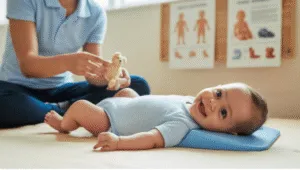
Causes of Pediatric Physical Therapy for Plagiocephaly?
In case the condition has been diagnosed in infants, the most common treatment is pediatric physical therapy for plagiocephaly. Putting the baby on his back for a very long time is the main cause of plagiocephaly as it exerts pressure on one side of the affected head. Other causal factors are:
- Placement in the womb: The babies that were positioned in a particular manner when pregnant are likely to develop flat spots on their heads.
- Tight neck muscles (Torticollis): In case the baby has a condition known as torticollis, which causes the neck muscles to be stiff and restrict movement of the head, they are also likely to develop a flat spot.
- Little time in tummy position: Insufficient supervised tummy time may result in flattened spots since the babies are on their backs most of the time.
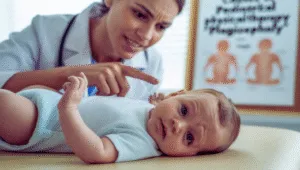
Symptoms of Pediatric Physical Therapy for Plagiocephaly?
A flat spot on one side of the head of the baby is the most evident sign of plagiocephaly. Nonetheless, the other symptoms may be:
- Face asymmetry: One forehead or ear may be more forward than the other.
- Neck tightness: The baby with torticollis will find it hard to move his or her head to one side.
- Deformed skull: The top of the skull may end up having an irregular shape as the flat surface may buckle; this is because of the pressure exerted on the head over time.

How Pediatric Physical Therapy Helps with Plagiocephaly
Physical therapy for plagiocephaly aims to resolve the problems that provoke faces of the head. This is aimed at restoring the skull shape and good development of the head. Examples of some of the techniques are:
1-Repositioning and Positioning Techniques
Repositioning is also one of the most terrific techniques, and it simply means the gentle movement of the head of the baby, which is occasionally changed over the course of the day in order to lessen the burden on the flat side. The aspect of repositioning the baby when sleeping, being fed, or just during play is taught to the parents.
2-Abb belly Exercises
Pediatric physical therapy of plagiocephaly involves exercises done during tummy time, as this allows strengthening of the neck and shoulder muscles in the baby. These activities facilitate a healthy growth of the head since they compel the baby to raise his/her head and put less pressure on the skull.
3-Exercises on neck stretching
In case there exists torticollis, then the physical therapists will lead the parents in simple exercises in stretching the neck to ensure that the neck muscles of the baby become flexible. This can assist the baby to turn his or her head more easily, and there will be no additional pressure on one side of the head.
4-Special Made-to-Fit Helmets or Molding Caps
Pediatric physical therapy for Plagiocephaly intervention as a method of plagiocephaly sometimes entails the use of home-designed helmets or molding caps. The job of these devices is to exert light force on the rounded surfaces of the skull and permit the flat surfaces to bulge. Adults normally recommend the use of a helmet when the baby is six months or older, and the helmets can last several months.
Treatments of Pediatric Physical Therapy for Plagiocephaly?
Pediatric physical therapy for plagiocephaly is usually complemented with other options so as to achieve optimum results. These are some of the usual treatment methods:
- Physical Therapy: Physical therapists assist infants to move their heads in the right way, develop neck muscles, as well as develop the ability to sit straight.
- Repositioning: Parents are also advised on the aspects of positioning of the baby during sleeping and resting so that exaggerated pressure on a particular area can be eliminated.
- Helmet Therapy: Helmet or molding caps are also advisable to reshape the skull of a baby with moderate to severe plagiocephaly.
- Cranial Remodeling Therapy: In more serious cases, the remodeling cranial therapy can be performed in order to reform the skull gradually.
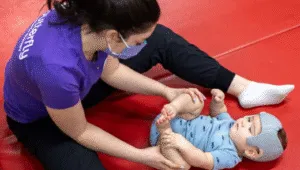
Why Early Intervention is Important for Plagiocephaly
Pediatric physical therapy for plagiocephaly is the treatment of the sooner, the better the results. Early introduction of the therapy is most effective since, before the shape of the baby’s head has become too fixed, the head can be easily remodeled and the symmetry of the skull can be restored. Motor problems or developing asymmetrical faces are newly identified as some of the problems that can be prevented in time with an early intervention. To have the most beneficial outcome, parents should seek therapy when they first notice the signs of plagiocephaly, preferably when the child is younger than six months.
The Impact of Pediatric Physical Therapy on Head Shape Correction
Physical therapy for a baby with plagiocephaly plays an important role in rectifying the shape of the baby. Therapy decreases the pressure that builds up on the flat part of the head, hence promoting the growth of the portions on which the skull may have been distorted. The main objective is to achieve a well-balanced head shape, and pediatric physical therapy to treat plagiocephaly works by using exercises, repositioning, and activities by the parents at home. The sooner one starts with the therapy, the more will be the success of the therapy will be towards a complete correction of the head shape.
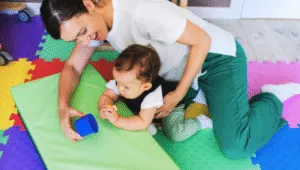
The Role of Pediatric Physical Therapy in Preventing Plagiocephaly
Pediatric physical therapy for plagiocephaly is critical for the prevention of flat head syndrome among infants. Therapists have a chance to educate parents on the repositioning techniques and tummy time to decrease the risk of developing plagiocephaly. Repositioning avoids straining of the baby’s head, and this is very necessary in attaining a round skull. The physical therapy of plagiocephaly with pediatric physical therapy focuses on the fact that early treatment is necessary to prevent greater complications. Using these practices, there is a reduced risk of permanent deformity due to the shape of the head of the babies. Occupational Therapy helps with Sensory Processing Disorder, also providing additional support for overall development when integrated with physical therapy.
How Supports Healthy Skull Growth
Physical therapy involved in the treatment of plagiocephaly ensures that the skull grows healthily in the pressure that was on the flat side of the skull is relieved with the help of physical therapy. One of them is the neck-strengthening exercises that enable the baby to move the head as he or she wishes. It is known to give the tummy time to have the muscles in place to balance the development of the skull. Pediatric Physical Therapy for Plagiocephaly is aimed at obtaining an even pressure distribution, making the child’s head more roundish. This eventually led to better symmetry as well as natural development of the skull of the baby.
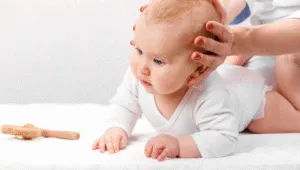
Key Milestones in Pediatric Physical Therapy
During pediatric physical therapy for plagiocephaly, milestones are identified in order to follow the progress. The first step is on repositioning and tummy time, which play a significant role in remedying the head shape. The main objective during therapy is the progression of head rotation and neck muscles. These markers represent that the therapy is basically improving the flattening. Pediatric physical therapy for plagiocephaly guarantees that any phase of treatment results in the baby being a step closer to the desired goal of having a more symmetrical head shape.
When to Seek Pediatric Physical Therapy for Plagiocephaly: A Parent’s Guide
It is necessary to understand at what age it is possible to go to a pediatric physical therapy due to plagiocephaly in order to achieve the best results. When you see that the head of your baby is flattened on any side, then you ought to think of therapy. Cure when at a tender age will avoid additional deformities and deliver faster outcomes. Plagiocephaly physical therapy particularly works in cases where it is initiated before the age of six months. Pediatric Physical Therapy for Plagiocephaly is invaluable in making sure that the time of therapy starts at the appropriate age of the child.
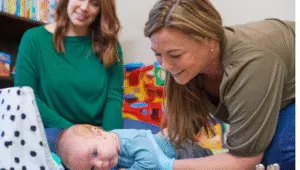
The Benefits of Early Pediatric Physical Therapy for Plagiocephaly
The early administration of Pediatric Physical Therapy for Plagiocephaly helps in a comprehensive procedure in the management of the condition. Early intervention is used to achieve better results in the correction of head shape faster. The babies who are treated early, under the age of six months, are the ones who demonstrate greater improvement in decreasing the flatness of the skull. This treatment aims at strengthening and repositioning the neck that enhance the regaining of the natural shape of the head. Prevention of possible complications, including delays in motor development and facial asymmetry, is one more product of early physical therapy.
Long-Term Effects of Pediatric Physical Therapy for Plagiocephaly
The implications of pediatric physical therapy for plagiocephaly changes may be permanent on the development of a child. After the shape of the skull is set to normal, the therapy is still taken to guide healthy motor ability, maintaining good posture, and the movement of the head. When treatment is commenced early, their development of the affected babies is rarely impaired due to abnormal head shape disorders, though autism affects motor skill development and may require additional therapeutic considerations. Additional treatment also causes the baby to exercise his muscles, thus improving coordination.
faqs
Q1: At what age should I begin pediatric physical therapy for plagiocephaly?
This should begin as early as the plagiocephaly is detected, and normally during the initial months of life. Earlier, the treatment brought improved results.
Q2: Can helmet therapy be applied to my baby who has plagiocephaly?
Helmet therapy is effective in cases where babies have a moderate or severe form of plagiocephaly. An evaluation by a physical therapist will be done on your baby so that the decision on whether a helmet is proper or not can be made.
Q3: Is there a cure to plagiocephaly through physical therapy?
When repositioning is combined with physical therapy, the extent of plagiocephaly can be greatly minimized, and the additional deformity can be prevented to a greater degree.
Q4: How many days will my baby receive physical therapy to cure plagiocephaly?
The therapy may vary depending on the extent of the condition. The majority of babies will require several months of therapy, and the changes will be seen in several weeks.
Q5: Is it possible to correct plagiocephaly without a helmet?
With mild cases, plagiocephaly and repositioning through pediatric physical therapy are sufficient to rectify the condition. More severe cases are usually treated with the use of helmets.
Conclusion:
Pediatric physical therapy for plagiocephaly among children is of great significance in avoiding future afflictions associated with the flat head syndrome. To reform your baby regarding its head shape and the development process, you can assist it with early interventions and appropriate treatment. Parents can treat the condition of plagiocephaly and support the normal growth of the child through repositioning techniques, tummy time, neck exercises, and, with the help of helmet treatment, in case necessary. In case you suspect that your baby has the signs of plagiocephaly, you should contact a pediatric physical therapist to discuss the situation and create an optimal solution to these issues.
